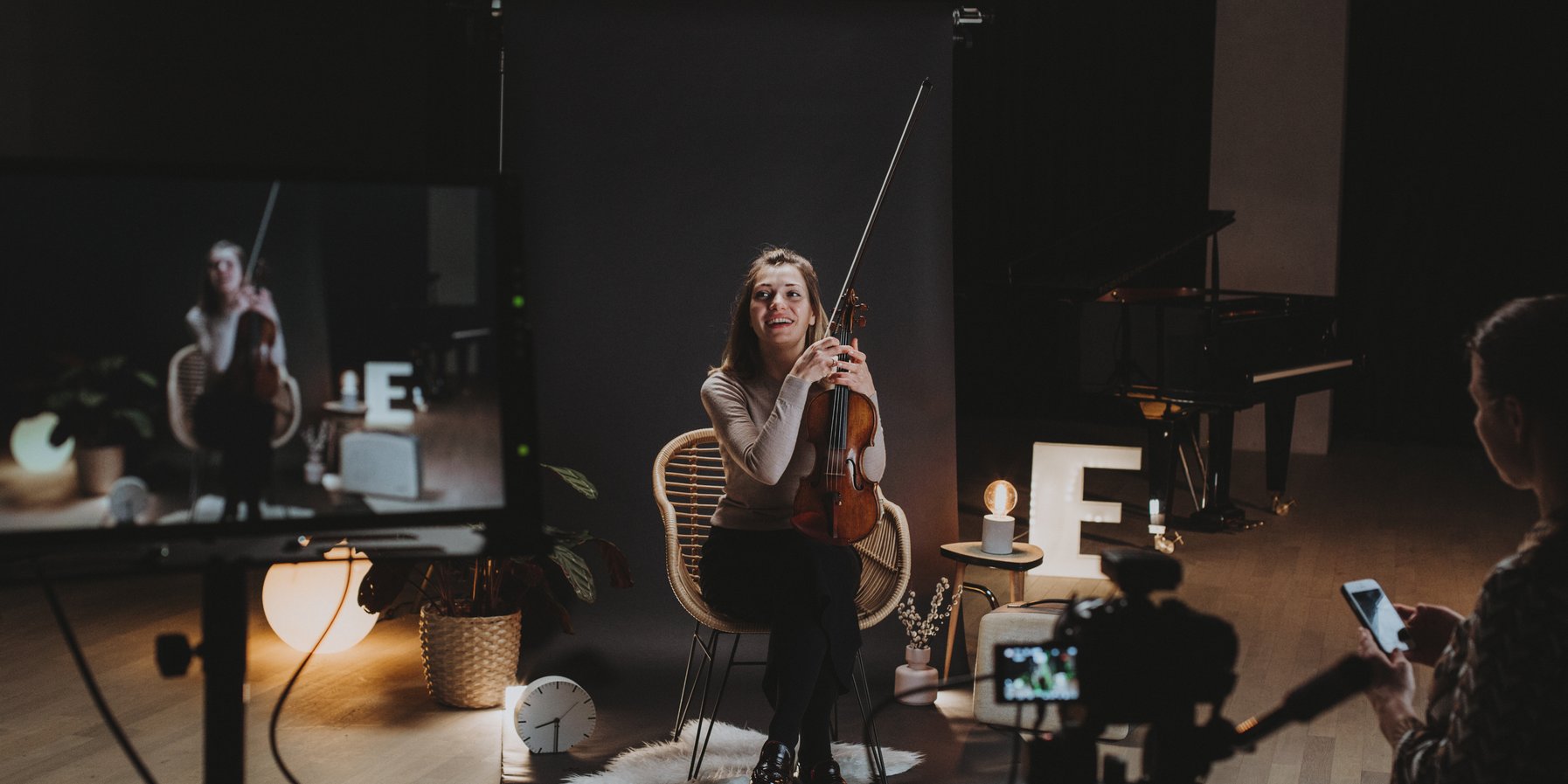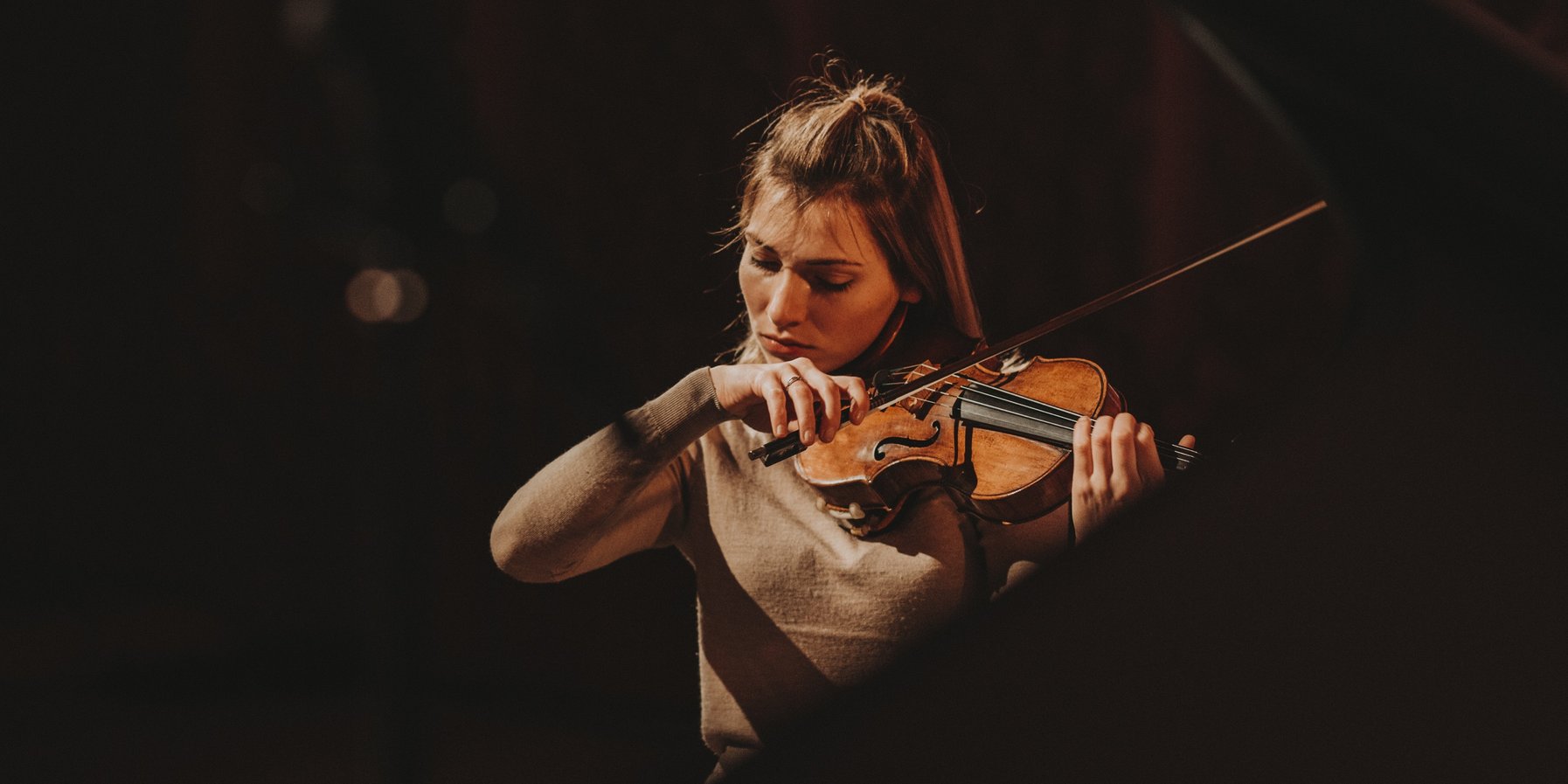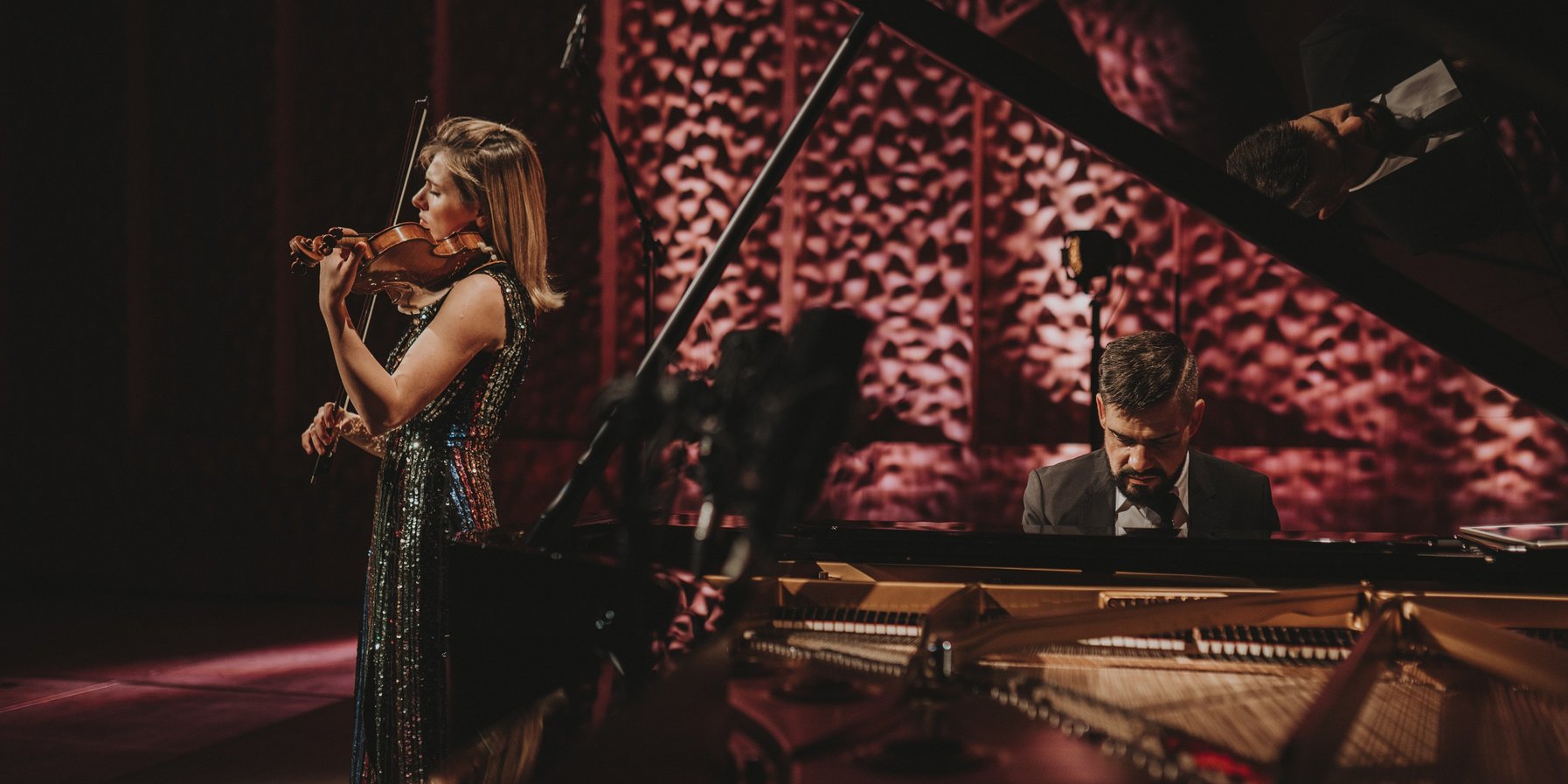She has the »ability to grip the audience with her strength of personality and impressive gestures« – this is how trade magazine »The Strad« described talented violinist Diana Tishchenko. The members of the international Gustav Mahler Youth Orchestra share that opinion: they appointed her their youngest concertmaster ever.
After Tishchenko already showed her mettle together with the Symphoniker Hamburg in 2016, she now returns as a »Rising Star« – with works by Claude Debussy and César Franck as well as a new composition written specially for her by Portuguese composer Vasco Mendonça.
Rising Stars Festival 2021
Hear tomorrow's stars perform today. Five concert-streams available on demand.

The Artist
- Ukrainian violinist (b. 1990)
- Joined the Gustav Mahler Youth Orchestra at the age of 18, and later became the youngest concertmaster in the orchestra's history
- 2018: Grand Prix Jacques Thibaud at the international Long-Thibaud-Crespin Competition
- 2018: Took part in the Kronberg Academy's prestigious chamber music biennale
- 2019: Released her debut album »Strangers in PARadISe«
-
Diana Tishchenko (complete biography)
The announcement that Diana Tishchenko will be a Rising Star of the European Concert Hall Organisation (ECHO) in the 2020/21 season is testament to the high esteem in which she is held by critics and audiences alike.
In November 2019 her debut album was released on Warner Classics, to universal critical acclaim. Entitled »Strangers in PARadISe«, it is a hommage to four great composers – Ravel, Ysaye, Enescu, and Prokofiev – on whom 1920s Paris had a huge influence. BBC Music Magazine awarded the album five stars, while Gramophone Magazine complimented her for a »genuinely distinctive, individual voice« as well as »beauty of tone, polish and range of colours«. Le Figaro wrote: »An album that confirms, with the yardstick of Prokofiev, but also Ravel and Enescu, the astonishing maturity of the artist.«
Past and upcoming engagements include appearances with the Deutsche Symphonie-Orchester Berlin, Symphoniker Hamburg, Shanghai Symphony Orchestra, Taipei Symphony Orchestra, Munich Chamber Orchestra, Orchestre National d’Ile de France, Orchestre Philharmonique de Strasbourg, Orchestre National des Pays de Loire, Baden-Baden Philharmonic and Shenzhen Symphony Orchestra, working with conductors such as Long Yu, Lahav Shani, Eliahu Inbal, Joshua Weilerstein, Yaron Traub, Ion Marin and Christian Ehwald. Appearances at major festivals include Salon de Provence in 2019, the Verbier Festival, Festspiele Mecklenburg-Vorpommern, the Salzburg Chamber Music Festival, the Internationales Musik Festival Koblenz and La Folle Journée de Nantes 2019 in the closing concert broadcast to millions worldwide.
On hearing her debut concert with the DSO Berlin at the Berlin Philharmonie under Joshua Weilerstein, German newspaper Der Tagesspiegel gave her a glowing review, writing: »[Tishchenko] compels the listener even in the first measures of Dmitri Shostakovich’s Violin Concerto No. 1… With a tone of incessant, nuance-rich intensity, she opens our eyes to the inner drama of this piece [...] Simply genius!«
2018 was a momentous year for her containing several highlights: in November 2018 she was awarded the Grand Prix Jacques Thibaud at the legendary Long-Thibaud-Crespin International Competition in Paris by jury chair Renaud Capuçon.
An enthusiastic chamber musician, in May 2018 she participated in »Chamber Music Connects the World«, the renowned biennial celebration at the Kronberg Academy, performing chamber music with artists such as Gidon Kremer, Steven Isserlis and Christian Tetzlaff.
Diana Tishchenko is a laureate of several international competitions including the Shanghai Isaac Stern International Violin Competition 2018, First Prize at the Felix Mendelssohn-Bartholdy Music Academy Berlin Competition 2017, First Prize at the 2014 Lyon International Chamber Music Competition (Violin and Piano Duo category), the International ARD Competition in Munich and the David Oistrakh International Violin Competition in Moscow.
Born in the Crimea, Ukraine in 1990, Diana Tishchenko began studying music at early age, eventually continuing an intensive education at the Lysenko Specialized Music School in Kiev. Soon after, she entered the Gustav Mahler Youth Orchestra, where she was concertmaster until 2013, working with Sir Colin Davis, Franz Welser-Möst, Herbert Blomstedt, Antonio Pappano and Daniele Gatti and performing in Europe's most renowned concert venues. She studied for her master and artist diploma degrees at the HfM Hanns Eisler in Berlin with Ulf Wallin, to whom she was assistant later on, and with Boris Kuschnir at the Graz University of Arts. Upon graduating she performed Prokofiev's Violin Concerto No. 2 at the Konzerthaus Berlin conducted by Lahav Shani. Her musical mentors include Ferenc Rados, Rita Wagner, Saschko Gawriloff, Steven Isserlis and Sir András Schiff.
-
José Gallardo (piano)

José Gallardo © Nikolas Hagele Born in Buenos Aires, Argentina, José Gallardo began taking piano lessons at the age of five. After studying at the Conservatory in Buenos Aires, he continued his studies with Professor Poldi Mildner at the Music Department of the University of Mainz and received his diploma in 1997. During this time he discovered his passion for chamber music. His musical mentors include artists such as Menahem Pressler, Alfonso Montecino, Karl-Heinz Kämmerling, Eberhard Feltz, Sergiu Celibidache, Rosalyn Tureck and Bernard Greenhouse.
José Gallardo has won numerous national and international prizes and plays concerts worldwide at venues such as the Elbphilharmonie in Hamburg, Philharmonie in Berlin, Wigmore Hall London or the Teatro della Pergola Florence. He has been invited to play at renowned festivals as Lockenhaus Chamber Music Festival, Verbier Festival, Lucerne Festival, Ludwigsburg Schlossfestspiele, Schwetzinger Festspiele, Music Days Hitzacker, Kaposfest Ungarn, Cello Festival Kronberg and Chopin Festival in Warsaw.
José Gallardo’s comprehensive chamber music activities and collaborations in Europe, Asia, Israel, Oceania and South America connect him with Vilde Frang, Barnabás Kelemen, Gidon Kremer, Linus Roth, Benjamin Schmid, Nils Mönkemeyer, Tomoko Akasaka, Andreas Ottensamer, Nicolas Altstaedt, Julius Berger, Maximilian Hornung, Benedict Klöckner, Miklós Perényi and others.
He is a sought-after pianist for studio productions. More than 20 CDs have been released by Warner, Deutsche Grammophone, Challenge Records Int., Genuin, NEON, Oehms Classics and Naxos as well as television and radio productions by BR, SWR, MDR, BBC, RAI and others.
From 1998 to 2008 he was a lecturer at the Department of Music at the University of Mainz, since autumn 2008 he has been teaching at the Leopold Mozart Center of the University of Augsburg. Since 2013 he is, together with Andreas Ottensamer, artistic director of the Bürgenstock Festival, a chamber music festival located in Lucerne.
Nominated by Philharmonie de Paris and Casa da Música Porto
The Programme
Claude Debussy (1862–1918)
Sonata in G Minor for Violin and Piano
Vasco Mendonça (*1977)
A Box of Darkness with a Bird in its Heart for Solo Violin / commissioned by Casa da Música Porto, Cité de la Musique - Philharmonie de Paris and European Concert Hall Organisation (ECHO)
César Franck (1822–1890)
Sonata for Violin and Piano in A Major M 8
Backstage impressions
Going to a concert with Diana Tishchenko :From the series »Concert for beginners«
From the living room to the concert hall in five steps: Diana Tishchenko shows how a concert evening works.
Available in German only.
About the music
Claude Debussy :Sonata in G minor for Violin and Piano
»Six Sonates pour divers instruments composées par Claude Debussy, Musicien Français.« – thus the title page of the first edition of the Debussy violin sonata. But the composer didn't manage to write the total of six sonatas for different instruments as planned: the first performance of the Sonata for Violin and Piano, given by violinist Gaston Poulet with Debussy himself at the piano, was to be the composer's last public appearance. One year later, he died of cancer.
Debussy took the idea of a musical »six-pack« from 18th century practice, when chamber-music works were nearly always published in sets of six – see Mozart and Haydn for examples. But Debussy actually preferred to find inspiration in his countryman, Baroque composer Jean-Philippe Rameau, whose simple elegance he admired. Thus he avoided typical features of the classical sonata: his first movement has two themes, it's true, but no development section. It is light and carefree in mood. The Intermède that follows is reminiscent of Baroque models with its almost uninterrupted semiquaver rhythm, while the closing movement likewise has a uniform rhythm.
Text: Jürgen Ostmann

Vasco Mendonça :A Box of Darkness with a Bird in its Heart für Violine solo / Kompositionsauftrag von Casa da Música Porto, Cité de la Musique - Philharmonie de Paris und European Concert Hall Organisation (ECHO)
The result of the 2016 US election was a decisive event for Afro-American poet Terrance Hayes, and in response he wrote the collection »American Sonnets for My Past and Future Assassin«, where in over 70 sonnets he deals with subjects like racism, masculinity and politics – in other words, topical issues relating to American society and its politics. Donald Trump is featured too, under the pseudonym »Mister Trumpet«.

The first line of one of these sonnets serves Vasco Mendonça as inspiration for his work commissioned for Diana Tishchenko. The full text is: »I make you a box of darkness with a bird in its heart«.
Mendonça says of his piece, with which he tries to capture the mood of the sonnets, albeit without words: »Terrance Hayes's sonnet series is a remarkable collection of poems: it captures the changing social and political chaos in America (and in the world) in a way that no newspaper article or academic essay could manage. An uneven, organic pulse permeates the first section – similar to how we breathe in moments of physical or emotional stress.
Part 2 consists of the soft, delicate chirruping of birds; its very high melody is almost a secret that is reluctantly shared, followed by an expressive lament. It made me think of a viola da gamba being played on a warm summer night – a sad tale of violence and loss. Finally, in the last movement, the energy of the music increases – inexorably and irreconcileably.«
César Franck :Sonata for Violine and Piano in A major, M 8
César Franck wrote his only violin sonata in 1886 as a wedding present for the violin virtuoso Eugène Ysaÿe, who is said to have tried it out on the spot. The French composer of Belgian-German descent arrived here at an individual interpretation of sonata form referred to as »cyclical form«, which prompted regular comparisons with Johannes Brahms. – As in many Brahms compositions, the four movements of the Franck sonata are linked by a joint musical nucleus that consists of a simple ascending and descending triad, presented first in the tentative opening bars of the piano, then by the violin. The rhythm is, if anything, simpler still: one short unstressed note is followed in each case by a long stressed note.

In this form, but often heavily altered, the individual elements of the melody recur at many places in the score, for example especially clearly at the end of the third movement, or in parts of the rondo finale. The melody itself covers an emotional range from gentle and charming at the outset through questioning mode to passionate and urgent or even dramatic. And it is precisely in these details that the appeal of this highly Romantic and melodic composition lies.
Text: Simon Chlosta, last updated: 25 Jan 2021
Translation: Clive Williams
The concert was recorded on 21 January 2021.
Promoter: HamburgMusik
In cooperation with ECHO - European Concert Hall Organisation
With support by M.M.Warburg & CO.















